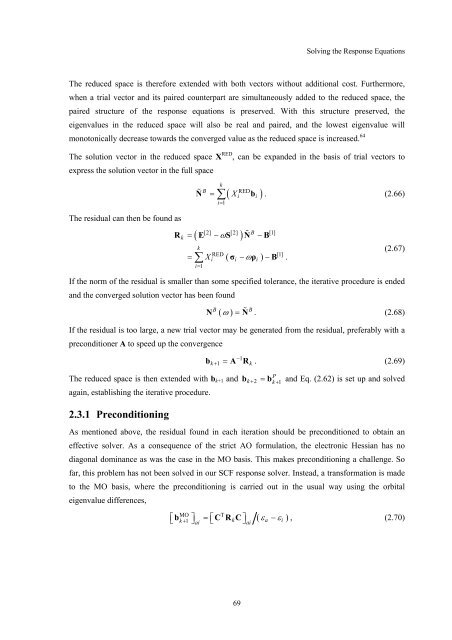Get my PhD Thesis
Get my PhD Thesis
Get my PhD Thesis
You also want an ePaper? Increase the reach of your titles
YUMPU automatically turns print PDFs into web optimized ePapers that Google loves.
Solving the Response Equations<br />
The reduced space is therefore extended with both vectors without additional cost. Furthermore,<br />
when a trial vector and its paired counterpart are simultaneously added to the reduced space, the<br />
paired structure of the response equations is preserved. With this structure preserved, the<br />
eigenvalues in the reduced space will also be real and paired, and the lowest eigenvalue will<br />
monotonically decrease towards the converged value as the reduced space is increased. 64<br />
The solution vector in the reduced space X RED , can be expanded in the basis of trial vectors to<br />
express the solution vector in the full space<br />
k<br />
B<br />
. (2.66)<br />
N<br />
= ∑<br />
i=<br />
1<br />
RED<br />
( X i bi<br />
)<br />
The residual can then be found as<br />
k<br />
( ω )<br />
R = E − S N<br />
−B<br />
k<br />
∑<br />
[2] [2] B [1]<br />
= X ( σ −ωρ ) −B<br />
i=<br />
1<br />
RED [1]<br />
i i i<br />
.<br />
(2.67)<br />
If the norm of the residual is smaller than some specified tolerance, the iterative procedure is ended<br />
and the converged solution vector has been found<br />
B<br />
B<br />
N ( ω ) = N . (2.68)<br />
If the residual is too large, a new trial vector may be generated from the residual, preferably with a<br />
preconditioner A to speed up the convergence<br />
k+ 1 =<br />
−1<br />
b A R . (2.69)<br />
The reduced space is then extended with b k+1 and bk<br />
+ 2 = b<br />
k + 1<br />
and Eq. (2.62) is set up and solved<br />
again, establishing the iterative procedure.<br />
2.3.1 Preconditioning<br />
As mentioned above, the residual found in each iteration should be preconditioned to obtain an<br />
effective solver. As a consequence of the strict AO formulation, the electronic Hessian has no<br />
diagonal dominance as was the case in the MO basis. This makes preconditioning a challenge. So<br />
far, this problem has not been solved in our SCF response solver. Instead, a transformation is made<br />
to the MO basis, where the preconditioning is carried out in the usual way using the orbital<br />
eigenvalue differences,<br />
k<br />
P<br />
MO<br />
T<br />
⎣⎡b + 1 ⎦⎤ = ⎣⎡C RkC ⎦⎤<br />
( εa −εi<br />
), (2.70)<br />
k ai ai<br />
69

















